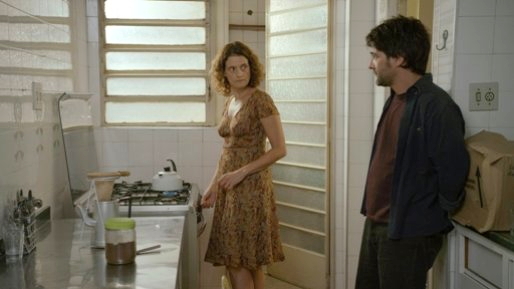
As the title implies, this is a story about an important day. Vera moves into an apartment in São Paulo in 1998. She’s in her mid-40s, not unattractive but perhaps a little uncertain/worried and both elated and stressed because of the move. Certainly, she’s not wealthy or elegant and this is a large unfurnished apartment, light and airy and spacious. But like our heroine it’s also a little run-down and in need of an uplift.
Vera seems to have quite a lot of furniture, books and household goods and two removal men soon appear to bring everything up to the apartment. But suddenly another man appears in one of the rooms. Where as he come from? Vera clearly knows him, but who is he? It’s difficult to discuss this film without revealing crucial spoiler information about the narrative, but I’ll try. The mysterious man refers to Vera’s past and this is a story about the ‘disappeared’ of Brazil. In this sense the film belongs to that category of narratives found in several Latin American countries, each with a history of political repression. In Brazil under the military dictatorship of 1964-85 arrest, imprisonment and torture of dissidents was responsible for the ‘disappearance’ of many individuals. In 1995 the Brazilian Government admitted the violations of human rights in the dictatorship period and 300 families were compensated for the ‘disappearance’ of relatives via legislative action. At one point the director, Tata Amaral, takes the text of the legislation and plays it over the two actors as if it was being projected onto them. You can probably guess what this means.

Hoje was the only one of the four films I saw on the Brazilian Weekender at HOME which was not introduced. There is very little about it on IMDB or Wikipedia. It was released in Brazil in 2013 and won prizes at Brazilian and Argentinian festivals but apart from one page in Brazilian from which I’ve taken the images here, it is difficult to find out much. It doesn’t seem to have travelled to other festivals. IMDB suggests that the aspect ratio is 1.78:1 implying it was shot for TV (i.e. in the 16:9 format). It looked to me more like 1.85:1 but IMDB also suggests that it was financed by HBO Latin America. If it was intended more for television that might make sense. There is really only one main set (Vera does go down to the street below for two short sequences). It had something of the feel of a TV play about it although the script is adapted from a novel.
I enjoyed the film and especially Denise Varga’s performance. I was also struck by the set design and the cinematography (which both won prizes for Vera Hamburger and Jacob Solitrenick respectively). It was interesting to see a film about the personal stories associated with resistance to authoritarian regimes – and it is noticeable that the film was produced and released when the Workers’ Party held power in Brazil.
